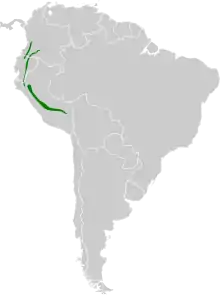| Golden-collared honeycreeper | |
|---|---|
 | |
| Male in Ecuador | |
| Scientific classification | |
| Domain: | Eukaryota |
| Kingdom: | Animalia |
| Phylum: | Chordata |
| Class: | Aves |
| Order: | Passeriformes |
| Family: | Thraupidae |
| Genus: | Iridophanes Ridgway, 1901 |
| Species: | I. pulcherrimus |
| Binomial name | |
| Iridophanes pulcherrimus (P.L. Sclater, 1853) | |
 | |
| Synonyms | |
| |
The golden-collared honeycreeper (Iridophanes pulcherrimus) is an uncommon species of Neotropical bird in the tanager family Thraupidae. It is the only member of the genus Iridophanes.
It is found in Colombia, Ecuador, and Peru. Its natural habitats are subtropical or tropical moist montane forests and heavily degraded former forest.
Taxonomy
The golden-collared honeycreeper was formally described in 1853 by the English zoologist Philip Sclater from a specimen collected near Bogotá in Colombia. He coined the binomial name Tangara pulcherrima.[2][3] It is now the only species placed in the genus Iridophanes that was erected by Robert Ridgway in 1901.[4][5] The genus name Iridophanes combines the Ancient Greek iris meaning "rainbow" and -phanēs meaning "showing". The specific epithet pulcherrimus is Latin for "very beautiful".[6]
A molecular phylogenetic study of the tanager family published in 2014 found that the golden-collared honeycreeper and the green honeycreeper (Chlorophanes spiza) were sister species.[7]
Two subspecies are recognised:[5]
- I. p. pulcherrimus (Sclater, PL, 1853) – central Colombia through east Ecuador to south-central Peru
- I. p. aureinucha (Ridgway, 1879) – west Colombia to northwest Ecuador
References
- ↑ BirdLife International (2016). "Iridophanes pulcherrimus". IUCN Red List of Threatened Species. 2016: e.T22722961A94795653. doi:10.2305/IUCN.UK.2016-3.RLTS.T22722961A94795653.en. Retrieved 12 November 2021.
- ↑ Sclater, Philip (1853). "Description de deux nouvelles espèces d'oiseaux". Revue et Magasin de Zoologie Pure et Appliquée. 2nd series (in French). 5: 480.
- ↑ Paynter, Raymond A. Jr, ed. (1970). Check-List of Birds of the World. Vol. 13. Cambridge, Massachusetts: Museum of Comparative Zoology. pp. 385–386.
- ↑ Ridgway, Robert (1901). "New birds of the families Tanagridae and Icteridae". Proceedings of the Washington Academy of Sciences. 3: 149–155 [150].
- 1 2 Gill, Frank; Donsker, David; Rasmussen, Pamela, eds. (July 2020). "Tanagers and allies". IOC World Bird List Version 10.2. International Ornithologists' Union. Retrieved 23 October 2020.
- ↑ Jobling, James A. (2010). The Helm Dictionary of Scientific Bird Names. London: Christopher Helm. pp. 207, 324. ISBN 978-1-4081-2501-4.
- ↑ Burns, K.J.; Shultz, A.J.; Title, P.O.; Mason, N.A.; Barker, F.K.; Klicka, J.; Lanyon, S.M.; Lovette, I.J. (2014). "Phylogenetics and diversification of tanagers (Passeriformes: Thraupidae), the largest radiation of Neotropical songbirds". Molecular Phylogenetics and Evolution. 75: 41–77. doi:10.1016/j.ympev.2014.02.006. PMID 24583021.
External links
